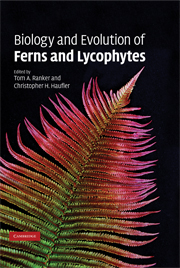Book contents
- Frontmatter
- Contents
- List of contributors
- Preface
- Acknowledgments
- Part I Development and morphogenesis
- 1 Photoresponses in fern gametophytes
- 2 Alternation of generations
- 3 Meristem organization and organ diversity
- Part II Genetics and reproduction
- Part III Ecology
- Part IV Systematics and evolutionary biology
- Index
- References
2 - Alternation of generations
Published online by Cambridge University Press: 11 August 2009
- Frontmatter
- Contents
- List of contributors
- Preface
- Acknowledgments
- Part I Development and morphogenesis
- 1 Photoresponses in fern gametophytes
- 2 Alternation of generations
- 3 Meristem organization and organ diversity
- Part II Genetics and reproduction
- Part III Ecology
- Part IV Systematics and evolutionary biology
- Index
- References
Summary
Introduction
What is meant by the term “alternation of generations”? There is no consensus on this, but a plethora of definitions and interpretations. For example: “The alternation of a sexual phase and an asexual phase in the life cycle of an organism. The two phases, or generations, are often morphologically, and sometimes chromosomally, distinct.” This is the current Encyclopedia Britannica version, one of the broadest, and one of the most defensible. One alternative is: “The succession of multicellular haploid and diploid phases in some sexually reproducing organisms …” (Purves et al., 2004). The latter is typical of the definitions found in biological textbooks, and as we shall see, restricts the process too much to be useful to fern biologists. The essential feature of the process upon which most authors agree is the presence of distinct multicellular forms. This distinguishes a set of organisms from those with only a single multicellular phase (such as humans, which reproduce, at least at present, via single-celled gametes that, on fusion, generate a multicellular phase morphologically comparable with the parent form that generated the gametes). Organisms with a single multicellular phase include those like ourselves, where the conspicuous phase is diploid (“diplonts”), and those in which the haploid phase is the only one with more than single cells (“haplonts”).
The possession of two different free-living forms allows each to exploit different environments. The tiny spores of the ferns allow genes to travel far beyond the immediate vicinity of the parent.
- Type
- Chapter
- Information
- Biology and Evolution of Ferns and Lycophytes , pp. 49 - 74Publisher: Cambridge University PressPrint publication year: 2008
References
- 8
- Cited by

